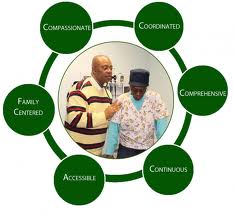Summary: What is PCMH? What does it mean to provide patient centered care? What are the foundations of this healthcare  model?
model?
Summary: What is PCMH? What does it mean to provide patient centered care? What are the foundations of this healthcare  model?
model?
Patient Centered Medical Homes are not physical places but a model of healthcare based on the principles of providing care which is accessible, coordinated, comprehensive, patient centered and is committed to quality and safety. Wow, that is a mouthful. Let’s break down each part.
What is accessible care?
Accessible means readily available at the convenience of the patient. Some of the activities surrounding accessible care are: extended office hours, access to care providers on a 24/7 basis, online appointment scheduling, patient access to medical records through electronic mechanisms, shorter wait times, and wave scheduling.
What is coordinated care?
Coordinated care is centered around the primary care physician who is given the responsibility to coordinate care with other health care professionals to make sure everyone is informed about all aspects of the patient’s care. This involves electronic medical records and conversations with specialists, laboratories and radiology just to name a few. Rather than each health care provider only having access to the specific care he/she is providing, care is coordinated through the continuum of care.
What is comprehensive care?
Comprehensive care encompasses treating the whole person and not one individual symptom or issue within a silo. It involves taking into account all issues a patient might be experiencing and coming up with a treatment plan in which a minimal number of side effects are incurred. It involves making sure that treating one issue won’t exacerbate another issue or impede the treatment process.
What is patient centered care?
Patient centered care focuses on the patient. How simple is that? The patient and his/her family are involved in the decisions surrounding  his/her care. The patient is able to provide input and make choices in regard to diagnosis, treatment, and follow-up. Rather than the physician just telling the patient what is going to happen, it becomes a two-way conversation and therefore much more interactive.
his/her care. The patient is able to provide input and make choices in regard to diagnosis, treatment, and follow-up. Rather than the physician just telling the patient what is going to happen, it becomes a two-way conversation and therefore much more interactive.
What does it mean to be committed to quality and safety?
All healthcare is becoming more focused on providing quality outcomes and keeping the patient safe while under the care of their physician. Measures are being introduced daily to track quality and patient safety, with reimbursement being tied to these outcomes. Additionally, the public is becoming more and more astute as to the quality measures and how particular hospitals fare in the ratings. Consumers have a choice to go to any facility they would like. Many of these decisions are trending toward quality as opposed to just proximity. Wouldn’t you rather drive a little further to find a facility that is dedicated to providing quality care?
So why do we need patient centered medical homes? Providing care which adheres to all of the guidelines above will help reduce healthcare costs, reducing unnecessary hospital re-admissions, and return to focusing upon prevention and wellness. It is more proactive rather than reactive approach. With so many choices and so much available wouldn’t you choose healthcare which is accessible, coordinated, comprehensive, patient-centered, and focused upon quality and patient safety?






